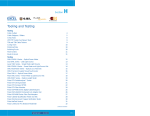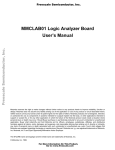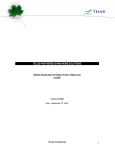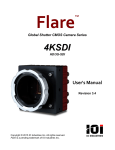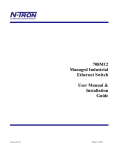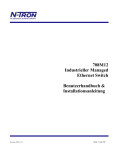Download Dicon VX500 Operating instructions
Transcript
VX500 Fiberoptic Switch Operation Manual 91500 Revision B 2 DiCon Fiberoptics VX500 Fiberoptic Switch Copyright © 1998 DiCon Fiberoptics, Incorporated. All rights reserved. Printed in the United States of America. No part of this manual may be reproduced, in any form or by any means, electronic or mechanical, including photocopying, without the express written permission of DiCon Fiberoptics. We have reason to believe that a number of the company and product names appearing herein constitute trademarks or have been designated as such by their respective holders. No attempt has been made to designate these words as trademarks or as registered trademarks. The inclusion, or exclusion of a word or term is not intended to affect, or express a judgment on, the validity or legal status of the word or term as a trademark, or other proprietary term. The information provided within this manual has been carefully reviewed for technical accuracy. DiCon Fiberoptics reserves the right to correct technical or typographical errors at any time, without prior notice. In no event shall DiCon Fiberoptics be liable for errors contained herein, or for incidental or consequential damages arising out of or related to, this document or the information contained in it. Warranty DiCon Fiberoptics warrants this product to be free from defects in both workmanship and performance for a period of one year from the time of original shipment. During the warranty period, DiCon Fiberoptics will, at its option, repair or replace any material found to be defective. The foregoing warranty extends to all cases, except where the product has been damaged through misuse, mishandling, inadequate maintenance, owner modification, failure to follow the installation and operating instructions provided by DiCon Fiberoptics, flood, fire or other events outside our reasonable control. EXCEPT AS SPECIFIED HEREIN, DICON FIBEROPTICS MAKES NO OTHER WARRANTIES, EXPRESSED OR IMPLIED, INCLUDING BUT NOT LIMITED TO, THE IMPLIED WARRANTIES OF MERCHANTABILITY AND FITNESS FOR A PARTICULAR PURPOSE. DICON FIBEROPTICS SHALL NOT BE LIABLE FOR DAMAGES RESULTING FROM LOSS OF DATA, PROFITS, USE OF PRODUCTS, OR INCIDENTAL OR CONSEQUENTIAL DAMAGES. This limitation of the liability of DiCon Fiberoptics will apply regardless of the form of action whether based on contract, tort, or any other legal theory. All Returns Contact DiCon Fiberoptics before returning any product. DiCon will provide a Return Material Authorization (RMA) number and shipping instructions. No product will be accepted for return without an RMA number clearly marked on the outside of the shipping material. Any unit that is returned under warranty, but for which evidence of misuse or mishandling is found, will be subject to testing and processing fees, in addition to any repair costs. DiCon Fiberoptics will cover any freight costs for returning warranty returned material to the customer. The customer is responsible for covering any freight costs for sending materials to DiCon Fiberoptics. The customer is responsible for all freight costs for returned materials found to be out of warranty. Use the original packing materials when returning material to DiCon Fiberoptics. If the original packing materials are unavailable, the customer is responsible for ensuring adequate packing materials are used to prevent damage during shipping. 91500 Revision B 3 Contents Product Overview ....................................................................................................... 5 Optical Switch Module ............................................................................................... VX500 Interface Board .............................................................................................. Connecting to the Interface ................................................................................. Reading the Status LED ............................................................................................ Thermal Considerations ............................................................................................. 5 5 6 6 6 Switch Operation ........................................................................................................ 7 Starting the Switch ..................................................................................................... 7 Resetting the Switch .................................................................................................. 7 Losing Power to the Switch ....................................................................................... 8 Selecting an Output Channel ..................................................................................... 8 Simplex 1 × N Configurations .............................................................................. 8 Synchronous Duplex 1 × N Configurations ....................................................... 10 2 × N Non-Blocking Configurations ................................................................... 11 2 × N Blocking Configurations ........................................................................... 13 Maintaining Channel Position .................................................................................. 14 Timing Parameters .................................................................................................. 15 Calculating Switching Time ...................................................................................... 16 Switch Control ........................................................................................................... 17 Controlling the VX500 Using a PC Printer Port ....................................................... 18 Specifications ............................................................................................................. 20 Device Housing ......................................................................................................... 20 Handling Fiberoptic Components and Cables ................................................. 22 Handling Fiberoptic Cables ...................................................................................... Storing Optical Connectors ...................................................................................... Cleaning Optical Connectors ................................................................................... Mating Optical Connectors ...................................................................................... 22 22 22 23 October 20, 1998 4 DiCon Fiberoptics VX500 Fiberoptic Switch 91500 Revision B Product Overview 5 Product Overview DiCon’s VX500 Fiberoptic Switch is a multi-channel fiberoptic switch designed for integration within products that require 1 × N or 2 × N optical switch routing. The design of the VX500 is based on patented technology which enables precise fiber-to-fiber positioning of either singlemode or multimode fibers. Optical Switch Module The VX500 optical switch module is an opto-mechanical switch that allows selection of an individual fiber channel by means of a high-resolution stepper motor. The stepper motor moves one or two common fibers into direct alignment with one or two of several output fibers using DiCon’s patented moving fiber technology. The VX500 is optically passive, operating independently of data rate, data format, and optical signal direction. Some of the terms used to describe the internal components of VX500 optical switch module are illustrated in Figure 1. Figure 1: The Internal Components of the VX500 Optical Proximity Sensor Optically Off Channel 0 Channel 1 Channel 2 Channel 3 Moving Armature Common Moving Fiber Output/Input Fixed Fibers Channel N VX500 Interface Board The VX500 switch module contains an electronic interface board that converts TTL input signals to the switch's optical channel position. The important components of the interface are labeled in Figure 2. The twelve-pin interface connector has six data inputs (RESET and <D4:D0>) and a STROBE input as well as two status outputs. The BUSY output indicates whether the device is busy performing an operation or ready to receive new switching instructions. The ERROR output indicates when an error has occurred. The board requires a constant +12 VDC supply both during switching and switch hold. October 20, 1998 6 DiCon Fiberoptics VX500 Fiberoptic Switch Connecting to the Interface The electrical connector on the DiCon VX500 Switch is a male twelve-pin 0.100-inch rightangle square-pin friction-lock header (Molex part number 22-12-2124). To mate to this connector, use a corresponding female receptacle housing (Molex part number 22-01-3127 or equivalent) and contacts (Molex part number 08-56-0110 or equivalent). The mating connector can be obtained from Molex (Tel: (708)969-4550) or from DiCon Fiberoptics, Inc. The maximum length of the control cable is two meters. Use shielded cable for lengths greater than one meter. Figure 2: The VX500 Interface Board (Top View) Twelve-Pin Electrical Connector Pin 1 LED Status Indicator Fiber Pigtails Switch Housing Interface Board Reading the Status LED The status LED provides a constant visual indication of the state of the switch. The four possible states are defined in the following table. Appearance State Green Yellow Red None Ready. The switch is operating properly and ready to receive switching instructions. Busy. The device is performing a switch operation. Error. A user error or device malfunction has occurred. Off. No power to the switch. Thermal Considerations The VX500 generates about 3 watts of heat continuously. The switch may not perform correctly if it is allowed to overheat (50°C max.). Under some circumstances, a vented air flow may be necessary in order to keep the housing temperature within range. Warning ! 91500 Revision B The switch may not perform correctly if it is allowed to overheat (50°C max.). Under some circumstances, a vented air flow may be necessary in order to keep the housing temperature within range. Switch Operation 7 Switch Operation The twelve-pin interface is used for supply power, channel selection, and status checking. The following table defines the signals associated with each pin. Table 1: Interface Pin Assignments Pin Number Signal Name Signal Type 1 2 3 4 5 6 7 8 9 GND GND D0 D1 D2 D3 D4 STROBE BUSY Power Power Input Input Input Input Input Input Output 10 ERROR Output 11 RESET Input 12 POWER Power Description Signal ground. Power ground. The D0 input is the LSB of the channel address. The D1 input is bit 1 of the channel address. The D2 input is bit 2 of the channel address. The D3 input is bit 3 of the channel address. The D4 input is the MSB of the channel address. The STROBE input is a falling-edge-trigger clock signal. The BUSY output is high when the switch is busy, and low when the switch is ready. The ERROR output is low during normal operation. A high ERROR output indicates that the requested channel is out of range (user error) or that a stepper motor or proximity switch error has occurred (device malfunction). Set RESET to low to return the switch to the reset position, and to high to choose a different output channel. Power supply input (+12VDC ±5%, 300mA max.) Starting the Switch To start the switch, apply power (+12 VDC ±5%, 300mA max.) to the POWER line. A stable voltage with less than 10mV RMS ripple is recommended. The switch requires a 970-ms initialization period upon power up while the switch armature returns to reset position. Do not apply TTL input to the data lines (D0, D1, D2, D3, D4, STROBE, and RESET) during initialization. Switch control may lock up if data is applied during initialization. If the switch locks up, cycle the supply power and restart the switch. Warning ! Applying TTL-level signals to the data lines before or during switch initialization may lock up switch control. Do not apply TTL-level signals to the data lines until power has been applied to the POWER input for 970ms. During the 970-ms initialization period, the BUSY and ERROR outputs as well as the optical outputs are invalid. Resetting the Switch When the VX500 is in the reset position (also called the park position, channel zero, or optical off), there is no optical connection to any output channel. Set the switch to the reset position to prevent optical data from passing through the switch, or to reset the stepper motor. During a reset operation, optical noise may appear on various output channels as the armature rotates. October 20, 1998 8 DiCon Fiberoptics VX500 Fiberoptic Switch One way to reset the switch is to cycle the supply power to the switch. The switch returns to the reset position following the initial application of power to the POWER pin (see “Starting the Switch” on page 7). To return the switch to the reset position without interrupting the supply power, set the RESET input to low and apply a STROBE pulse. The RESET input is latched by the falling edge of the STROBE signal, respecting hold, setup, and pulse width constraints (see Table 6). The BUSY output remains high until the reset operation is complete and the device is ready to receive additional instructions. Losing Power to the Switch If the supply power is interrupted the switch does not latch in its current position. Instead, it loses direct fiber-to-fiber alignment, breaking the optical connection. When supply power is restored the switch automatically restarts, returning to the reset position. Selecting an Output Channel To choose a specific channel, set the RESET input to high, set the channel address inputs (<D4:D0>) to the appropriate value (see Tables 2, 3, 4, and 5), and apply a STROBE pulse. The inputs are latched by the falling edge of the STROBE signal, respecting hold, setup, and pulse width constraints (see Table 6). The BUSY output will go high until the STROBE pulse has ended, the switch operation is complete, and the device is ready to receive additional instructions. Note that the BUSY signal will remain high until the end of the STROBE pulse, even if the switch operation is complete and the optical connection is stable. If the latched value of the channel address (<D4:D0>) is the same as the previous latched value, the BUSY signal will go high for 60–80ms even though there is no switch movement. If the latched value of the channel address (<D4:D0>) indicates an out-of-range position, the BUSY and ERROR signals will go high for 60–80ms. The following sections list the switch channel number associated with each data-input setting for simplex 1 × N, synchronous duplex 1 × N, 2 × N blocking, and 2 × N non-blocking switches, respectively. Simplex 1 × N Configurations The relationship between the optical inputs and outputs in a VX500 simplex 1 × N switch is shown in Figure 3. Figure 3: Simplex 1 × N Switch Configuration 0 1 1 2 3 N The arrangement of the fiber pigtails on a VX500 1 × N switch is shown in Figure 4. The left diagram applies to switch units with up to 16 output channels. The right diagram applies to units with 17–32 output channels. 91500 Revision B Switch Operation 9 Figure 4: Simplex 1 × N Channel Order (Top View) CHANNEL N CHANNEL N CHANNEL 3 CHANNEL 2 CHANNEL 1 COMMON CHANNEL 3 CHANNEL 2 CHANNEL 1 COMMON To select the output channel of a simplex 1 × N switch with up to 32 output channels, set the five channel address inputs (<D4:D0>) and the RESET input as indicated in Table 2, then strobe the device. Table 2: Control Codes For Simplex 1 × N Configurations RESET D4 D3 D2 D1 D0 Active Channel 0 1 1 1 1 1 1 1 1 1 1 1 1 1 1 1 1 1 1 1 1 1 1 1 1 1 1 x 0 0 0 0 0 0 0 0 0 0 0 0 0 0 0 0 1 1 1 1 1 1 1 1 1 1 x 0 0 0 0 0 0 0 0 1 1 1 1 1 1 1 1 0 0 0 0 0 0 0 0 1 1 x 0 0 0 0 1 1 1 1 0 0 0 0 1 1 1 1 0 0 0 0 1 1 1 1 0 0 x 0 0 1 1 0 0 1 1 0 0 1 1 0 0 1 1 0 0 1 1 0 0 1 1 0 0 x 0 1 0 1 0 1 0 1 0 1 0 1 0 1 0 1 0 1 0 1 0 1 0 1 0 1 0 reset 1 2 3 4 5 6 7 8 9 10 11 12 13 14 15 16 17 18 19 20 21 22 23 24 25 26 October 20, 1998 10 DiCon Fiberoptics VX500 Fiberoptic Switch Table 2: Control Codes For Simplex 1 × N Configurations (Continued) RESET D4 D3 D2 D1 D0 Active Channel 1 1 1 1 1 1 1 1 1 1 1 1 1 1 1 1 1 1 0 0 1 1 1 1 1 1 0 0 1 1 0 1 0 1 0 1 27 28 29 30 31 32 Synchronous Duplex 1 × N Configurations The relationship between the optical inputs and outputs in a VX500 synchronous duplex 1 × N switch is shown in Figure 5. Figure 5: Synchronous Duplex 1 × N Switch Configuration 0 1 2 0 1-1 1-2 2-1 2-2 N-1 N-2 The arrangement of the fiber pigtails on a VX500 synchronous duplex 1 × N switch is shown in Figure 6. The left diagram applies to switch units with up to 16 output channels (1 × 8). The right diagram applies to units with 18–32 output channels (1 × 9 to 1 × 16). Figure 6: Synchronous Duplex 1 × N Channel Order (Top View) CHANNEL N-2 CHANNEL N-2 CHANNEL 1-2 CHANNEL 1-1 COMMON 2 COMMON 1 CHANNEL 1-2 CHANNEL 1-1 COMMON 2 COMMON 1 91500 Revision B Switch Operation 11 To select the output channel of a simplex 1 × N switch with up to 50 output channels (1 × 25), set the five channel address inputs (<D4:D0>) and the RESET input as indicated in Table 3, then strobe the device. Table 3: Control Codes for Synchronous Duplex 1 × N Configurations RESET D4 D3 D2 D1 D0 Common 1 Active Channel Common 2 Active Channel 0 1 1 1 1 1 1 1 1 1 1 1 1 1 1 1 1 1 1 1 1 1 1 1 1 1 x 0 0 0 0 0 0 0 0 0 0 0 0 0 0 0 0 1 1 1 1 1 1 1 1 1 x 0 0 0 0 0 0 0 0 1 1 1 1 1 1 1 1 0 0 0 0 0 0 0 0 1 x 0 0 0 0 1 1 1 1 0 0 0 0 1 1 1 1 0 0 0 0 1 1 1 1 0 x 0 0 1 1 0 0 1 1 0 0 1 1 0 0 1 1 0 0 1 1 0 0 1 1 0 x 0 1 0 1 0 1 0 1 0 1 0 1 0 1 0 1 0 1 0 1 0 1 0 1 0 0 reset 1-1 2-1 3-1 4-1 5-1 6-1 7-1 8-1 9-1 10-1 11-1 12-1 13-1 14-1 15-1 16-1 17-1 18-1 19-1 20-1 21-1 22-1 23-1 24-1 25-1 0 reset 1-2 2-2 3-2 4-2 5-2 6-2 7-2 8-2 9-2 10-2 11-2 12-2 13-2 14-2 15-2 16-2 17-2 18-2 19-2 20-2 21-2 22-2 23-2 24-2 25-2 2 × N Non-Blocking Configurations The relationship between the optical inputs and outputs of a VX500 2 × N non-blocking switch is shown in Figure 7. Figure 7: 2 × N Non-Blocking Switch Configuration -1 0 2 1 block 1 2 3 N The arrangement of the fiber pigtails on a VX500 2 × N non-blocking switch is shown in Figure 8. The left diagram applies to switch units with up to 16 output channels. The right diagram applies to units with 17–32 output channels. October 20, 1998 12 DiCon Fiberoptics VX500 Fiberoptic Switch Figure 8: 2 × N Non-Blocking Channel Order (Top View) CHANNEL N CHANNEL N CHANNEL 2 CHANNEL 1 COMMON 2 COMMON 1 CHANNEL 2 CHANNEL 1 COMMON 2 COMMON 1 To select the output channel of a 2 × N non-blocking switch with up to 32 output channels, set the five channel address inputs (<D4:D0>) and the RESET input as indicated in Table 4, then strobe the device. Table 4: Control Codes For 2 × N Non-Blocking Configurations 91500 Revision B RESET D4 D3 D2 D1 D0 Common 1 Active Channel Common 2 Active Channel 0 1 1 1 1 1 1 1 1 1 1 1 1 1 1 1 1 1 1 1 1 1 1 1 1 1 x 0 0 0 0 0 0 0 0 0 0 0 0 0 0 0 0 1 1 1 1 1 1 1 1 1 x 0 0 0 0 0 0 0 0 1 1 1 1 1 1 1 1 0 0 0 0 0 0 0 0 1 x 0 0 0 0 1 1 1 1 0 0 0 0 1 1 1 1 0 0 0 0 1 1 1 1 0 x 0 0 1 1 0 0 1 1 0 0 1 1 0 0 1 1 0 0 1 1 0 0 1 1 0 x 0 1 0 1 0 1 0 1 0 1 0 1 0 1 0 1 0 1 0 1 0 1 0 1 0 0 reset 1 2 3 4 5 6 7 8 9 10 11 12 13 14 15 16 17 18 19 20 21 22 23 24 25 -1 reset 0 block 1 2 3 4 5 6 7 8 9 10 11 12 13 14 15 16 17 18 19 20 21 22 23 24 Switch Operation 13 Table 4: Control Codes For 2 × N Non-Blocking Configurations (Continued) RESET D4 D3 D2 D1 D0 1 1 1 1 1 1 1 1 1 1 1 1 1 1 1 1 1 1 1 1 1 0 0 0 1 1 1 1 0 1 1 0 0 1 1 1 0 1 0 1 0 1 Common 1 Active Channel Common 2 Active Channel 26 27 28 29 30 31 25 26 27 28 29 30 31 blocka a. When the channel address is set to N (the highest input channel), Common 1 is blocked and Common 2 is aligned with Channel N. 2 × N Blocking Configurations The relationship between the optical inputs and outputs of the VX500 2 × N blocking switch is shown in Figure 9. Figure 9: 2 × N Blocking Switch Configuration -1 0 1 block 2 2 1 block 3 block N block The arrangement of the fiber pigtails on a VX500 2 × N blocking switch is shown in Figure 10. The left figure applies to switch units with up to 8 output channels. The right figure applies to units with 9–16 output channels. Figure 10: 2 × N Blocking Channel Order (Top View) CHANNEL N CHANNEL 2 CHANNEL 1 COMMON 2 COMMON 1 CHANNEL N CHANNEL 2 CHANNEL 1 COMMON 2 COMMON 1 October 20, 1998 14 DiCon Fiberoptics VX500 Fiberoptic Switch To select the output channel of a 2 × N blocking switch with up to 16 output channels, set the five channel address inputs (<D4:D0>) and the RESET input as indicated in Table 5, then strobe the device. Table 5: Control Codes For 2 × N Blocking Configurations RESET D4 D3 D2 D1 D0 Common 1 Output Channel Common 2 Output Channel 0 1 1 1 1 1 1 1 1 1 1 1 1 1 1 1 1 1 1 1 1 1 1 1 1 1 1 1 1 1 1 1 1 x 0 0 0 0 0 0 0 0 0 0 0 0 0 0 0 0 1 1 1 1 1 1 1 1 1 1 1 1 1 1 1 1 x 0 0 0 0 0 0 0 0 1 1 1 1 1 1 1 1 0 0 0 0 0 0 0 0 1 1 1 1 1 1 1 1 x 0 0 0 0 1 1 1 1 0 0 0 0 1 1 1 1 0 0 0 0 1 1 1 1 0 0 0 0 1 1 1 1 x 0 0 1 1 0 0 1 1 0 0 1 1 0 0 1 1 0 0 1 1 0 0 1 1 0 0 1 1 0 0 1 1 x 0 1 0 1 0 1 0 1 0 1 0 1 0 1 0 1 0 1 0 1 0 1 0 1 0 1 0 1 0 1 0 1 0 reset 1 block 2 block 3 block 4 block 5 block 6 block 7 block 8 block 9 block 10 block 11 block 12 block 13 block 14 block 15 block 16 block -1 reset 0 block 1 block 2 block 3 block 4 block 5 block 6 block 7 block 8 block 9 block 10 block 11 block 12 block 13 block 14 block 15 block 16 Maintaining Channel Position To maintain channel position, keep the STROBE signal high and do not interrupt supply power. 91500 Revision B Switch Operation 15 Timing Parameters Figure 11: VX500 Switch Timing Tstb STROBE Tsu Th <D4:D0> RESET Tbsy Tsw BUSY OPTICAL OUTPUT Figure 12: VX500 Power-Up Timing POWER Tpwr STROBE <D4:D0> RESET BUSY ERROR OPTICAL OUTPUT October 20, 1998 16 DiCon Fiberoptics VX500 Fiberoptic Switch Table 6: VX500 Timing Parameters Parameter Description Min. Max. Units Tsu Setup time. The channel address (<D4:D0>) and RESET inputs must remain stable preceding the falling edge of STROBE. Hold time. The channel address (<D4:D0>) and RESET inputs must remain stable following the falling edge of STROBE. 100 — ns 150 — ns STROBE pulse width.a STROBE low to BUSY high. During this period the switch maintains a valid connection to the previous output channel. Switching time. During this period there may be invalid optical transmission on all channels. Power-up delay. The switch may lock up if TTL-level signals are applied to the data inputs during this period. Status and optical outputs are unreliable. 150 6 × 107 500 ns 300 + (16 × N) 970 ms Th Tstb Tbsy Tsw Tpwr — — — ns ms a. DiCon recommends a low pulse width of 1 µsec to 10 µs. Calculating Switching Time The time period that begins at the falling edge of the STROBE signal and ends upon completion of the switching operation can be divided into three constituent periods. The first period begins when STROBE goes low and ends when BUSY goes high. During this period (500ns max.), the optical connection for the previous channel selection remains valid. The second period begins when BUSY goes high and the switch armature begins to move. It ends when the armature reaches the specified output channel. The period lasts for 16ms per switched channel, including blocked and duplex channels. During this period, optical output is invalid; optical noise may appear on various output channels as the armature rotates. The final period is called the debounce period. It ends when the armature is steady, the switch has established a valid optical connection, and BUSY goes low. The debounce period lasts for 300ms.1 Switching time is the sum of final two periods. For example, consider the calculation of total switching time for the following two scenarios: Switch From Channel 15 To Channel 1 (Simplex 1 × N Switch) (14 × 16 ms) + 300 ms = 524 ms Switch From Channel 2 To Channel 6 (2 × N Blocking Switch) (8 × 16 ms) + 300 ms = 428 ms Additionally, there are two special cases for calculating switching time. First, if a STROBE pulse is applied with no change in the latched value of the channel address (<D4:D0>), the BUSY line will go high for 60–80ms. Second, if a reset instruction is given twice in a row, the BUSY line will go high for 410ms max. For example, consider the total switching time for the following two scenarios: Switch From Channel 3 To Channel 3 60–80ms Switch From Channel 0 To Channel 0 410ms max. 1. The BUSY line will remain high until the end of the STROBE pulse, even if the switch operation is complete and the optical connection is stable. 91500 Revision B Switch Control 17 Switch Control Figure 13 illustrates the following sample control sequence for a 1 × N simplex switch. 1. Following power-up, the switch returns to reset position. After the initialization period, the device is ready to receive instructions. 2. The user brings STROBE high, brings RESET high to enable channel selection, and sets the desired channel address. The user applies a strobe pulse, sending the BUSY line high while the switch moves into alignment with channel 6. The BUSY line returns to low when the switch operation is complete and the device is ready to accept new instructions. 3. With the RESET line still high, the user changes the channel address and applies another STROBE pulse, the BUSY line goes high while the switch moves into alignment with channel 2. 4. Finally, the user brings RESET low and applies another STROBE pulse. The device disregards the channel address inputs. The BUSY line goes high while the switch returns to the reset position. Figure 13: Sample Control Sequence 1 2 3 4 +12 VDC RESET BUSY STROBE D0 D1 D2 D3 D4 SWITCH FUNCTION Off Power Up Auto Reset Ready Read 00101 Ready Read 00001 Ready Reset Request OUTPUT CHANNEL Not Valid Not Valid Channel 0 Reset Not Valid Channel 6 Not Valid Channel 2 Not Valid Ready Channel Reset October 20, 1998 18 DiCon Fiberoptics VX500 Fiberoptic Switch Controlling the VX500 Using a PC Printer Port It is possible to control the VX500 switch by connecting the interface board to a PC printer port and a power supply (+12VDC ±5%, 300 mA max.). The printer port has a 25-pin, Dshell connector. The recommended cable configuration for connection to the printer port is shown in Figure 15. The basic control flow for the VX500 is illustrated in Figure 14. For specific procedures for sending reset and switch instructions, see “Switch Operation” on page 7, “Timing Parameters” on page 15, and “Selecting an Output Channel” on page 8. Figure 14: Switch Control Flow START Power-Up +12 VDC Wait for 970 ms. Is the BUSY signal high? Yes No Is the ERROR signal high? No Send switch instruction 91500 Revision B Yes Send reset instruction Is the ERROR signal still high? No Yes STOP! Send for service Switch Control 19 Figure 15: Parallel Port Line Assignments POWER SUPPLY – + VX500 SWITCH GND GND D0 D1 D2 D3 D4 STROBE BUSY ERROR RESET POWER 1 2 3 4 4 6 7 8 9 10 11 12 PARALLEL PORT 1 2 3 4 5 6 7 8 9 10 11 12 13 14 15 16 17 18 19-25 -STROBE DATA BIT 0 DATA BIT 1 DATA BIT 2 DATA BIT 3 DATA BIT 4 DATA BIT 5 DATA BIT 6 DATA BIT 7 -ACK BUSY PE SLCT -AUTO FEED -ERROR -INIT -SLCT IN GND GND The following BASIC program can be used to control the VX500 from a PC printer port. The program switches channel-by-channel from channel 1 through channel 8. If an error is encountered, the program resets the switch. If the error persists, the program exits. The program expects the VX500 to be connected to the printer port as outlined in Figure 15. Depending on the speed of your PC, you may have to insert a delay after the STROBE low commands (lines 90, 150) in order to satisfy minimum pulse width constraints. 1 2 3 4 5 6 10 20 30 40 50 60 70 80 90 100 110 120 130 140 150 160 170 180 190 200 REM Testing program for VX500 controlled through PC printer port (PP). REM Address 379H is PP input byte (BIT3=ERROR; BIT7=BUSY). REM Address 378H is PP output byte (<BIT4:BIT0>=<D4:D0>; BIT7=RESET). REM Address 37AH is PP STROBE output (BIT0=STROBE). REM The printer port inverts the STROBE output. REM Note: Some computers use addresses 3BC, 3BD, & 3BE. WAIT 1 wait during power-up (970 ms min.) FOR K = 1 TO 8 STEP 1 step through channels 1 through 8 INBYTE = INP(&H379) read BUSY signal IF (INBYTE AND 128) <> 128 THEN GOTO 30 BUSY = HIGH, check again INBYTE = INP(&H379) read ERROR signal IF (INBYTE AND 8) = 8 THEN GOTO 130 ERROR = HIGH, reset device OUT &H378, K + 127 send channel & RESET to data bus OUT &H37A, 0 set STROBE high OUT &H37A, 1 bring STROBE low OUT &H37A, 0 set STROBE high NEXT K do the next channel STOP done! OUT &H378, 127 set RESET low OUT &H37A, 0 set STROBE high OUT &H37A, 1 bring STROBE low OUT &H37A, 0 set STROBE high WAIT 1 wait for reset INBYTE = INP(&H379) check ERROR IF (INBYTE AND 8) = 8 THEN STOP reset failed, send for service GOTO 20 reset succeeded, proceed with test October 20, 1998 20 DiCon Fiberoptics VX500 Fiberoptic Switch Specifications Table 7: Performance Specifications Parameter Minimum Typical Maximum Units — 0.6 1.2 dB — — -60 -20 -55 — dB dB — — 300+(16×N) ms — 10 million — — -80 — ±0.03 dB cycles dB — 780 — — 0.05 1650 dB nm 50 70 °C °C — Opticala insertion lossb back-reflection (singlemode fiber)c back-reflection (multimode fiber)c switching timed isolation durability repeatabilitye PDLf wavelength range Environmental operating temperature: storage temperature humidity 0 — -20 — 40°C / 90% RH / 5 days a. All specifications referenced without connectors. b. Measured at 23±5°C. c. Based on standard 1-meter pigtail length. d. Based on BUSY output pulse. Actual optical switching time may be faster. e. Sequential repeatability for 100 cycles at constant temperature after warm-up. f. Measured at 1550 nm. Device Housing The VX500 Switch is suitable for mounting on a panel or printed circuit board. Four mounting holes are provided. Do not remove the housing cover. Removal of housing cover voids warranty. Table 8: Housing Dimensions Parameter Height Width Depth Weightb Size 1 1 to 17 Channelsa Size 2 18 to 32 Channelsa Units 23.6 [0.93] 72.0 [2.83] 120.0 [4.72] 0.4 [0.8] 23.6 [0.93] 140.0 [5.51] 140.0 [5.51] 0.9 [2.1] mm [in.] mm [in.] mm [in.] kg [lb.] a. Including blocked and duplex channels b. Actual weight depends upon switch configuration. 91500 Revision B Device Housing 21 Figure 16: VX500 Chassis Size 1 Housing Figure 17: VX500 Chassis Size 2 Housing October 20, 1998 22 DiCon Fiberoptics VX500 Fiberoptic Switch Handling Fiberoptic Components and Cables Handling Fiberoptic Cables Your switch may come with fiber pigtail outputs. Treat cables with care to avoid cable damage and minimize optical loss. The minimum bend radius for most optical cables is 35mm. Never bend an optical cable more sharply than this specification. Optical performance will degrade and the cable may break. • Avoid bending the optical cable near a cable strain relief boot. Bending an optical cable near a strain relief boot is one of the easiest ways to permanently damage the optical fiber. • Avoid bending the optical cable over a sharp edge. • Avoid using cable tie wraps to hold optical cable. Tie wraps when tightened can create micro-bends or break an optical cable. Microbends can cause a dramatic reduction in optical performance. • Do not pull on the bare fiber as this can break the fiber inside the component. • Avoid using soldering irons near optical cable. Accidental damage can easily occur when an soldering iron is used near an optical cable. In addition, solder splatter can contaminate and permanently damage optical fiber connectors. • In order to obtain the most stable, repeatable optical performance, immobilize optical cables using wide pieces of tape or some form of mechanical cushion after the optical cables have been connected. Do not bend the fibers at the exit of the connector strain relief boot. The fiber will break if stressed at this point. FIBEROPTIC COMPONENT CONNECTOR FIBER PIGTAILS Do not bend the fibers at the exits of the switch housing. The fiber will break if stressed at these points. Storing Optical Connectors All switches are shipped with dust caps in place covering all optical connectors. Optical connectors should remain covered at all times when the instrument is not in use. Cleaning Optical Connectors Clean any exposed connector using a cleaning kit supplied by the connector manufacturer or high-grade isopropyl alcohol and a cotton swab. To clean with alcohol and a swab, dab the tip of a cotton swab in alcohol and then shake off any excess alcohol. The tip should be moist, not dripping wet. Stroke the swab tip gently across the surface of the connector and around the connector ferrule. Either allow the connector a minute to dry, or blow dry the connector using compressed air. Be careful when using compressed air because improper use may deposit a spray residue. 91500 Revision B Handling Fiberoptic Components and Cables 23 Mating Optical Connectors • Clean both connectors prior to mating. Any small particles trapped during the mating process can permanently damage the connector. • Insert the appropriate connector ferrule into the adapter smoothly. Do not allow the fiber tip to contact any surface. If the tip accidentally contacts a surface before mating, stop. Re-clean the connector and try again. • Tighten the connector until it is finger tight, or to the torque specified by the connector manufacturer. Do not over-tighten the connector as this can lead to optical loss and connector damage. • Check the optical insertion loss. If the loss is unacceptable, Remove the connector, reclean both ends of the mate, and reconnect. You may have to repeat this process several times before a low-loss connection is made. • After you make the connection, monitor the stability of the optical throughput for a few minutes. Optical power trending (slowly increasing or decreasing) is caused by the slow evaporation of alcohol trapped in the connection. Continue to monitor optical power until it stabilizes. If the loss is unacceptable, reclean the connectors and start again. October 20, 1998 DiCon Fiberoptics, Inc. 1331 Eighth Street Berkeley, CA 94710 USA World Wide Web www.diconfiberoptics.com

























